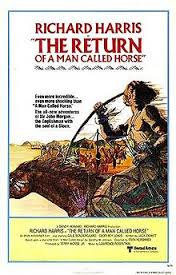
THE RETURN OF A MAN CALLED HORSE
US, 1976, 125 minutes, Colour.
Richard Harris, Gale Sondergaard, Geoffrey Lewis, Bill Lucking.
Directed by Irvin Kershner.
Whatever appealed to audiences in the original film is incorporated into this satisfying sequel, Return of a Man Called Horse. Indian life, white riff-raff, the Englishman-hero become Indian, the overtones of anthropology, especially in the alarming torture test of endurance, repeated here in more ritual form, not only for Sir John Morgan, but for the Yellow Hand braves and initiates. After a long pre-credits look at English life, the film takes us to a familiar West of brutality and survival, a sympathetic look at the oppressed Indian and the stuff of legend. A necessary kind of Western for our times to shake any complacency in presuppositions about white supremacy and its consequences.
1. Was this a good film? As a sequel, comparison with the original? Standing in its own right? Its recreation of atmosphere, study of themes? For what audience was it made? For those wanting more of the original in terms of hero, Indians, Indian way of life?
2. The importance of colour, Panavision? The re-creation of nineteenth century England and its style of life, the contrast with the American frontier, the fort, the Indian camp? The natural environment for the Indians and the west? Audience expectations from this? Western conventions? An Indian film,, the white man amongst Indians?
3. The significance of the prologue: Morgan and his restlessness after his experience in America. the details of his English way of life. the hunt. church-going. the prospect of marrying.. administering the estate, living the idle life of a well-to-do gentleman? Was this presented with credible detail? Did it help explain the motivation for his return?
4. The visual presentation of his return. the contrast visually of the American west with England? The portrayal of the Indians,. the Yellow Hand and their persecution, the massacre? The effect on the oppressed Indians. their dispirited way of life, loss of dignity and vitality. slaves of the whites?
5. The presentation of the whites and their Indian allies? The way of life in the fort, greed and brutality, the Commander and his obsession, his abuse of the Indians. the sexual abuse of the Indians. the violence and their deaths? The film's building up a need for retribution and redemption?
6. The significance of the return of Morgan on the Yellow Hands? Their welcoming him back. the reaction of the Chief, the men, the women and the children, his friends? The importance of showing the details of Indian way of life and Morgan involved in all of these?
7. The significance of the ritual? Its presentation in the previous film? The visual presentation of torture? The effect on Morgan, on the braves? The purpose? What did it prove, how necessary was it?
8. Morgan and his interaction with the whites at the fort? His pretending to be the fopping English gentleman, making a show of himself, his surveying the situation, his witnessing the shooting of the girl? His eluding his pursuer and killing him?
9. The picture of the Indians as they revived, the significance of their eating meat, their warriors, their pride?
10. The preparation for the raid? The details of the canvassing of the fort, the preparations of firearms and explosives for the attack?
11. Audience involvement in the raid itself? The massacre of the whites? The death of the Commander? Where did audience sympathies lie?
12. The film's comment on American history, on white and Indians and their interaction? The values of civilized way of life? The values of the civilized Indians?
13. The importance of this film for Anthropology. History. Indian legend, the legend of Morgan himself.